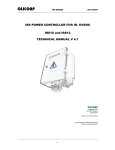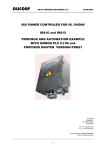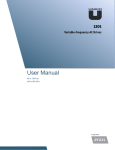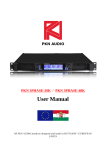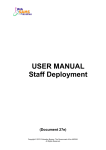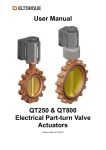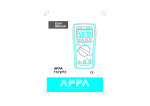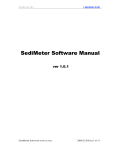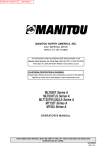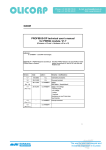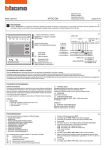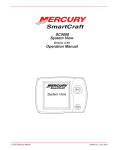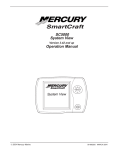Download OLICORP
Transcript
OLICORP IRS SERIES 07/02/2013 IRS POWER CONTROLLER FOR IR. OVENS NS IRS TECHNICAL MANUAL V 1.0 OLICORP Montbrillant 26 CH-1201 Geneva Switzerland Phone: +41 22 309 15 40 Local support is available Worldwide Check on www.olicorp.ch -1- OLICORP IRS SERIES 07/02/2013 CE relevant European directives............................................................................................. 4 Low Voltage compliance........................................................................................................ 4 EMC compliance................................................................................................................... 4 CE Label .............................................................................................................................. 4 CSA / CUS® Marking ............................................................................................................... 4 Profibus® standard compliance.............................................................................................. 4 Safety and security aspects .................................................................................................... 5 Symbols : ............................................................................................................................. 5 Safety:.................................................................................................................................. 5 PART 1 : DISCOVERING THE NS IRS ....................................................6 What is the NS-IRS system ?................................................................................................... 7 The NS-IRS is the top of the art solution to control power on IR ovens. .................................... 7 How do the NS-IRS systems compare to existing solutions ................................................... 8 Totally integrated solution : .................................................................................................... 8 Closed loop regulation for power regulation (V2 RMS / RLamps) ..................................................... 8 On-line Load fault detection : ................................................................................................. 8 Load impedance on-line monitoring and recording :................................................................. 8 Multi-channels :..................................................................................................................... 8 Power supply monitoring :...................................................................................................... 8 Scalability and modularity : .................................................................................................... 8 Profibus-DP Communications : .............................................................................................. 8 Multiple regulation algorithms :............................................................................................... 8 Hardware and software versions............................................................................................10 NS-IRS10 versions : ...........................................................................................................10 Software architecture :...........................................................................................................12 PC based software :.............................................................................................................13 Blue Tooth communication :..................................................................................................13 PLC Program : .....................................................................................................................13 PART 2 : NS-IRS SYSTEM FEATURES ................................................14 Cabling and lamps strategy : .................................................................................................15 NS-IRS Absolute maximum ratings : ................................................................15 REGULATION MODES :........................................................................................16 Phase angle regulation.........................................................................................................16 Zero crossing and advanced single cycle regulation ...............................................................17 Conclusion :.........................................................................................................................18 Integrated WARM-UP ramps : ................................................................................................19 Shortcuts and overloads : ......................................................................................................20 Overload message ...............................................................................................................20 CutOut message : ................................................................................................................20 Resistance measurement, closed loop regulation and dead lamps detection........................21 Why do we need to measure the resistance ? ........................................................................21 What is done by the NS-IRS ? ..............................................................................................21 EMC compliance ....................................................................................................................22 Harmonics and Flicker standards. .........................................................................................22 Harmonics : .........................................................................................................................22 Flickering :...........................................................................................................................23 Running conditions and cooling : .........................................................................................24 Performances : ....................................................................................................................24 Rth : ....................................................................................................................................24 Maximum internal temperature..............................................................................................24 Running conditions...............................................................................................................24 PART 3 : USING THE NS-IRS IN 6 STEPS ..........................................25 -2- OLICORP IRS SERIES 07/02/2013 Step 0 : Machine cabling : ......................................................................................................26 Step 1 : Product Identification :..............................................................................................27 Step 2 : Mechanical mounting : ..............................................................................................28 Mechanical configuration of the NS-IRS for integration into machines : ....................................28 Step 3 : Electrical connections :............................................................................................30 AC Power supply : ...............................................................................................................30 Connection to the Oven : .....................................................................................................30 DC Power supply and Profibus terminators ............................................................................32 Profibus termination: ............................................................................................................33 Profibus ID:..........................................................................................................................33 Step 4: Checking the NS-IRS configuration............................................................................34 Procedure:...........................................................................................................................34 List of firmware versions according to the model and usage : ..................................................35 Step 5: Automation strategy for 20.X Programs – Voltage regulation mode.......................36 System calibration................................................................................................................36 Starting the regulation ..........................................................................................................36 Treating the information back from the NS-IRS ......................................................................36 Stopping the regulation.........................................................................................................36 System Shutdown ................................................................................................................36 Exceptions...........................................................................................................................37 Step 5 : Automation strategy for 5.X Programs – Power regulation mode ...........................38 System configuration............................................................................................................38 System initialisation at start-up..............................................................................................38 Starting the regulation ..........................................................................................................39 Treating the information back from the NS-IRS .....................................................................39 System Shutdown ................................................................................................................39 Exceptions...........................................................................................................................40 PART 4 : TECHNICAL COMPLEMENTS ...............................................41 RS232 and USB connection : Firmware update and NS-IRS serial control.............................42 Overview : ...........................................................................................................................42 Hardware connection :..........................................................................................................42 Installing the software :.........................................................................................................42 Configuring the software :.....................................................................................................42 Using the software : .............................................................................................................43 Firmware update : ................................................................................................................44 Calibration : .........................................................................................................................45 To ensure a good process quality the NS-IRS calibration have to be check..............................45 Voltage calibration :..............................................................................................................45 Use a calibrate VRMS Voltmeter ...........................................................................................45 Measure the voltage between the two phases inside the NS-IRS ............................................45 Enter the value and tick “Calibrate voltage” ............................................................................45 Vrms read and Vrms expected mus be the same ...................................................................45 Current calibration : ..............................................................................................................46 Profibus DP : For PROGRAMS 5.X .........................................................................................47 Overview .............................................................................................................................47 Procedure to use a NS-IRS regulator with a PLC :..................................................................47 Protocol description and datagram format :............................................................................48 Summary : Basic steps to start the regulation (STD12 protocol) :............................................51 Profibus DP: For Programs 20.X ............................................................................................52 Overview .............................................................................................................................52 Procedure to use a NS-IRS regulator with a PLC: ..................................................................52 Protocol description and datagram format:.............................................................................54 Summary: Basic steps to start the regulation:.........................................................................55 LEDs ......................................................................................................................................56 -3- OLICORP IRS SERIES 07/02/2013 CE relevant European directives Low Voltage compliance The NS-IRS products carry the CE mark in compliance with the essential requirements of the European Low Voltage Directive 73/23/EEC of 19/2/73, amended by the directive 93/68/EEC of 22/7/93. The NS-IRS products installed and used in compliance with the procedures described in the present document meet the essential requirements of the European Low Voltage Directive. EMC compliance The NS-IRS products are compliant with the EMC requirements with respect to the European directives 89-336/EEC of the 05//03/89 amended by the 91-263/EEC, 92-31/EEC, 93-68/EEC, 93-97/EEC. The enforcement of this directive is done by standards: EN60204, EN50081-2 and EN50081-3 EM compliance has been certified by an approved EMC testing laboratory. Certificates are available upon request. More details about EM compliance are given later in this document. CE Label By fulfilling the requirements of the Low voltage and EMC regulations, the NS-IRS products are compliant with the CE directives. CSA / CUS® Marking The NS-IRS products CSA/UL compliance has been investigated by the CSA laboratories in Toronto, Canada. (May 2007). File number 1871799. Profibus® standard compliance The NS-IRS carries the Profibus-DP compliance label and is listed by the PNO organization under reference IRPC1012 with id number 0594Hex. -4- OLICORP IRS SERIES 07/02/2013 Safety and security aspects Symbols : This symbol means that failure to take note of the information given in this manual may have serious consequences for the safety of the personnel or may result in electrocution. This symbol means that failure to take note of the information given in this manual may have serious consequences for the installation, lead to incorrect operation of the product, or may damage the product. Safety: The installation, configuration, commissioning and maintenance of the NS-IRS products must only be carried out by personnel qualified and trained to work with low voltage electrical equipment in an industrial environment. The front door should not be opened except by competent technicians when connecting or disconnecting the device. Electrical isolation must be ensured between the equipment and the power supply. In both off and on modes, the NS-IRS regulator doesn’t ensure isolation from the power supply. One should pay attention to the fact that electrical shock may occure when touching the lamps or the cables coming from the NS-IRS. It is thus recommended to turn off the power supply (400 V) within 2 sec following the end of regulation. -5- OLICORP IRS SERIES PART 1 : DISCOVERING THE NS IRS -6- 07/02/2013 OLICORP IRS SERIES 07/02/2013 What is the NS-IRS system ? The NS-IRS is the top of the art solution to control power on IR ovens. The NS-IRS system aims to control up to 10 InfraRed lamps. Its modular design turns to be optimised for the control of IR ovens on blow molding machines. The NS-IRS is designed a IP65 cabinet that can be mounted in the machine nearby the oven. The NS-IRS replaces the successful PWR and IRS systems that has been widely used on blow moulding machines since 2002. More than 45’000 PWRs and IRSs actually run around the world. The NS-IRS - 10 channels - Single phase input + ground (185- 530 VAC 50 / 60 Hz) - I Max Total : 65 A - I Max / channel : 7.5 A RMS Advanced features : - Phase angle and advanced single cycle modes (zero crossing) - Dead Lamps detection and Load Resistance monitoring - Closed loop regulation (Power regulation based on Voltage and Current) - Warm-up ramps for tungsten lamps - Profibus DP communications - Voltage limitation to protect the lamps - Online Lamps resistance measurement - Power supply quality monitoring - Monitoring and recording of power supply variations. Installation is simplified by the means of : - Fast connecting terminators - 3 points fixation -7- OLICORP IRS SERIES 07/02/2013 How do the NS-IRS systems compare to existing solutions Totally integrated solution : The NS-IRS system is a complete power cabinet by itself. It includes the regulation controller, the power regulation stage (thyristors), and an integrated overload protection, all integrated in an IP65 cabinet. This concept makes it easy to connect and to mount. Maintenance is also greatly facilitated by suppressing complex electrical cabinets by small plug and play single units. Closed loop regulation for power regulation (V2RMS / RLamps) By measuring the current and the voltage as well, it is possible to know the exact power sent to the resistive loads. Doing this will avoid any power fluctuations due to the resistance spread or to the power supply irregularity . On-line Load fault detection : By measuring the load resistance and the system is able to detect load faults. This point is especially important for the blow moulding machines with a large number of lamps. Load impedance on-line monitoring and recording : The system is able to record the changes in the lamps resistance. This information may be used to survey the aging of the lamp. Multi-channels : The NS-IRS controls up to 10 channels. (IRS12 Models are available for 12 channels regulation) Power supply monitoring : In the 2013 version of the NS-IRS, the electrical characteristics of the power supply are monitored to record the variations on the Voltage and current, to detect transient signals and abnormal events. Scalability and modularity : The NS-IRS system is designed to be mount directly onto the machine nearby the oven. This concept is thus highly modular… Profibus-DP Communications : The NS-IRS modules are certified Profibus-DP slaves and can both receive settings and send alerts from/to the PLCs connected to this field-bus. Multiple regulation algorithms : The NS-IRS system currently supports phase angle, zero crossing and advanced single cycle. -8- OLICORP IRS SERIES NS-IRS brings a total control on the heating process • • • • Power and voltage regulation Closed loop on supply voltage Closed loop on lamps resistance Lamps controlled individually • Lamps resistance monitoring • logging of changes in the lamps resistance to ease the determination of their lifetime. • Fast detection of dead lamps • deterministic overload protection • Running from 185 up to 530 VAC • Possibility to use low voltage lamps on higher voltage supplies. • Over-voltage protection • Data logging, monitoring, consumption follow up • harmonics suppressor -9- 07/02/2013 OLICORP IRS SERIES 07/02/2013 Hardware and software versions NS-IRS10 versions : One Hardware, Two Softwares The NS-IRS operates 2 programs : The version 5.x used on standard blow molding machines The version 20.x used on Sidel® machines From 01-2013, ALL former 10 channels models will be replaced by the WO25.X version. PWR24B WO25.X Software V5.X PWRSDL WO25.X Software V20.X IRS10 STD WO25.X Software V5.X IRS10 SDL WO25.X Software V20.x Features Release date Firmware Isupply (A) Imax-thy (A) Nchannel Vsupply Frequency. Vcontroller Icontroller (A) WO 2.1 WO 25.x IRS 12 NS IRS STD SIDEL and STD Mar 2009 01 2013 V5.18 V5.18 or V20.16 70 70 7.5 7.5 12 10 185-530 VAC 47-63 Hz 24 VDC +/- 10% 0.25 0.25 200 A 32A C curve Ioverload Additional breaker for back line protection Interrupting capacity Running conditions (Non confined) Storage Accel. Protection Temperature rise inside the cabinet at full power with respect to outside. Power loss Size HxWxD Weight 6KA 5-45°C 5-55°C with T-5°C RMS over 24h, 8-80% HR n.c -20-60 °C, 5-95% HR 10G, 11ms, 2 times/s IP65 23°C 9.5°C 70 W 55 W 430X312X188 mm 15.4 kg 430x312x150m m 12.5 kg - 10 - OLICORP IRS SERIES Stainless steel Static cooling Fan Cooling Single hardware configuration for both regulation modes Phase angle Advanced single cycle Adjustable ramps for lamps pre-warming Power regulation VRMSxIInst Voltage regulation V2RMS Overload and surge protection Dead lamp detection Temperature survey Power supply survey GSD Min power / lamp Max power / lamp Serial control USB control Bluetooth control Datalog Update firmware soft Upgrade features soft POWER PLUG OVEN PLUG 24 DC PROFIBUS DP X X Option X X Option X X X X X X X X X X X X X - X X X : Turns off the regulation if Tinside > 70°C Yes, and an alarm is sent if the power to the lamp is not reached 2.0 2.0 10% Nom 10% Nom X X X X X Option Option X X Fast plug terminator – HAN100A from HARTING® Fast plug terminator – HAN32 from HARTING® Ecofast from HARTING - 11 - 07/02/2013 OLICORP IRS SERIES 07/02/2013 Software architecture : SUPERVISOR Serial communication based controller Can send regulation settings to the IRS and read resistances and alerts. Used also to upgrade the firmware and to write specific settings in the flash memory (RS l Link S eria 232) IBM Compatible Fast Logic OverLoad protection MICRO KERNEL Controls the programs execution and the memory IRS FIRMWARE Controls regulation Controls Communications (PFDP + Serial) Can be updated RAM MEMORY Power settings Lamps characteristics volatil Pr ofi bu s-D P 24 VDC 200-500 VAC 12 channels RS232 Profibus DP Permanent FLASH MEMORY : serial number ramps settings regulation mode zero setting communication mode OL-STEP7 Step 7 module to facilitate the PWR integration I/O module Profibus DP PLC Power module PLC automation. Sends the settings for each lamp in Watts Read the lamps' resistances and process the alarm messages Starts and stops the regulation this program is maintened by the customers. To ensure the maximal flexibility, the different programs used with the NS-IRS are distributed between : - The NS-IRS itself to retain recurrent settings or store special algorithms The machine’s PLC that starts/stops the regulation and sends the desired settings. A PC or LapTop that can be used for maintenance purpose - 12 - OLICORP IRS SERIES 07/02/2013 PC based software : SUPERVISOR : This program is used to connect a PC to a single NS-IRS using a serial or USB link. The program is used to test the NS-IRS, to monitor the status of the regulator and to upgrade the firmware. The NS-IRS intrinsic settings can also be set using this program. More information is given later in this document and in the SUPERVISOR User’s manual Blue Tooth communication : The NS-IRS can be optionally equipped with a Bluetooth dongle allowing to connect to the NSIRS using wireless communications. PLC Program : This program synchronises the regulation (start/stop) with the machine cycle and sends the power settings (Watts) to the NS-IRS according to the users’ needs. Different communication modes are available over profibus-DP, and thus, different PLC programming strategies can be used. More information is given later in this document. - 13 - OLICORP IRS SERIES PART 2 : NS-IRS SYSTEM FEATURES - 14 - 07/02/2013 OLICORP IRS SERIES 07/02/2013 Cabling and lamps strategy : It is possible to use the NS-IRS cabinet with several types of lamps and with different cabling topologies. - The NS-IRS automatically limits the Voltage sent to the lamp according to the type of lamp. It is thus possible to use 400 VAC lamps on 480 VAC supply. - The total current regulated by the power cabinet cannot exceed 65A for NS-IRS and 75 A for the IRS12. The total current / channel cannot exceed 7.5 A / channel for both products. The Overload current is set to 200 A. - NS-IRS Absolute maximum ratings : The NS-IRS is accepting input voltage between 185 VAC and 530 VAC, with frequencies ranging between 47 and 63 Hz. Power supply Voltage (VAC) +/-10% Lamp Nominal Voltage (Vrms) 208 230 400 415 440 480 230 ------------- 1700 1000 950 900 820 360 ------------- ------------- 2400 2300 2200 2000 400 ------------------------3000 2900 2700 2500 Green : Maximal power (W) for lamps for a given Power supply voltage and lamp nominal voltage. The minimal setting per channel is 10% of the nominal power of the lamp in power regulation mode. This limit is set to avoid current bursts with tungsten lamps as the Resistance of the lamp may slightly decrease when running at low power. - 15 - OLICORP IRS SERIES 07/02/2013 REGULATION MODES : Phase angle regulation The phase angle regulation relies on a powerful algorithm that monitors both the voltage and the current going through each load and then calculate the power dissipated in these loads. By knowing this exact power, the system is able to evaluate the ratio of the signal which should be removed to reach the targeted power in the lamps. Moreover, this online monitoring of the current and voltage is used to compute the exact resistance of the lamps and then to detect dead lamps. The phase angle is defined as θ, which is the delay while the circuit must remain opened for each half period. The greater θ is, the less energy remains in the signal. IN V SIGNAL (After Signal shaping) . Measurement of R for a given channel For each half period the current i is analysed to compute the θ angle for the next half period OUT I SIGNAL : SIGNAL REMOVED This method is accurate and one can achieve a precision of less than 0.3%.. The θ angle can be controlled with an accuracy of 1 µs. A filter must be integrated into the NS-IRS cabinet for the EMC compliance. Benefits from phase angle regulation : o o o o o High accuracy Almost no variation of the temperature of the filament along the time Possibility to run with European and American power supplies indifferently Possibility to run with 220, 400 and 480 VAC lamps indifferently Possibility to use 220 V lamps onto 400 and 480 supplies and 400 V lamps onto 480 V supplies Problems related to phase angle regulation : - 16 - OLICORP IRS SERIES 07/02/2013 The main problem related to phase angle regulation is the EMC compliance. For small systems the use of a dedicated EM filter ensures the compliance with EMC standard. Above 200kW, when using several NS-IRS modules, we have to consider also the machine design. For instance, a machine with poorly shielded cables from the regulators to the ovens may cause pick-up and correlated effects that could spoil the EM characteristics of the machine. A new type of power stage is actually tested. It uses a microsecond shifting algorithm between the different systems to reduce the correlated effects and ensure a fully E M compliance up to the MW even for poorly shielded machines. More information is available in the EMC section and in the regulation algorithms section. Zero crossing and advanced single cycle regulation In this mode, the regulation is done by removing an entire number of half-periods, evenly distributed onto a 1s period (100 half periods). The commutation of the thyristors is synchronous with the power to avoid EMC perturbations. The regulation accuracy is over 1%. The lamps may flicker. Basic description of the algorithm : The regulation is done using two quantities : o o P1/2 period : Integrated power during ½ period Σ 100(P period) : Energy in the latest 100 periods Using these two quantities, the number of periods to be removed within the next 100 periods is calculated. The Σ 100(P period) gives the global number of periods to be removed, while the P 1/2 period is used to correct low frequencies fluctuation of the input signal. The removed half period are distributed evenly to smooth the temperature variation of the filament along the time. IN V SIGNAL (After Signal shaping) . Measurement of R for a given channel OUT I SIGNAL SIGNAL REMOVED - 17 - OLICORP IRS SERIES 07/02/2013 Applications : The accuracy of the advanced single cycle is poor compared to the phase angle regulation. It can hardly be better than 1%. However this accuracy is good enough for the basic PET process. The main problems are related to the removal of several successive half periods. These “holes” are responsible for the flickering effect which occurs because of the lamps’ temperature fluctuation over the time. The flickering has a negative effect on the lamps lifetime as well as on the lighting homogeneity. Removing one ½ period corresponds to a signal shutdown during 10ms in the load. Depending on the lamps geometry the temperature of the load will fall from a few Kelvins, which is enough to cause a small flickering. It is thus really important to work with lamps adapted to the process. We recommend strongly to choose the lamps with a nominal power close to the expected settings.. Conclusion : By taking into account these different points it appears that the phase angle regulation which keeps an even filament temperature along the time, is certainly the best alternative for regulation. But, as the phase angle affects EMC compliance, and induces additional costs related to EMC filtering, it can be necessary to use advanced single cycle instead. This second way to regulate the power is also efficient when the expected power is close to the lamp’s nominal power. But, when the power is decreasing, flickering effects will occur and spoil the spectrum. We thus suggest to use it to save money and ensure EMC compliance, but we also recommend to adapt the lamps’ nominal power with respect to the settings that will be applied to these lamps. The best results will be achieved if the setting remains over 80% of the nominal power. - 18 - OLICORP IRS SERIES 07/02/2013 Integrated WARM-UP ramps : As a consequence of the cold lamps’ low resistance, the current at start-up may rise quickly leading to an overload (> 200 A) if all lamps are turned on simultaneously. To solve this problem one a warm-up algorithm included in the firmware. This feature should be configured according to the lamps used in the oven. In Supervisor program, it is possible to set 2 parameters : Power : The Power applied to the lamp during the warm up phase Threshold : Duration of the warm-up expressed in half Sine cycles. Exemple : 3 KW 400 VAC lamps Power = 3000 W, Threshold = 200 During 200 half periods (2 seconds at 50Hz) the first lamp will be warmed up with 3000 W. Then it will switch to the desired power with the standard regulation mode (phase angle or adv. single cycle) and it will start to warm the second lamp with 3000 W during 200 half periods…. - 19 - OLICORP IRS SERIES 07/02/2013 Shortcuts and overloads : Overload message Whenever the total admitted current goes above 200 A, the system will emit an Overload alarm and stop the regulation. Before turning the system on again you have to follow this procedure : - Take care that the power supply is off (no power) Check that there is not physical default on the electric circuitry Check the state of breakers inside the cabinet, and turn them ON. Turn the Power supply on Reset the alarm on the NS-IRS by turning the regulation off Start regulation again. - The system should NOT be reset and restarted automatically ! You MUST check the origin of the problem before starting again the power. If not, you may : o Endanger the technicians working around the machine o Damage the system by applying to much thermal stress onto the components CutOut message : The breaker will turn off when more than 32 A is applied to a group of 4 lamps. Remark : the breaker is C curve breaker. Fast transient states with high current will not turn the breaker off. Before turning the system on again you have to follow this procedure : - Take care that the power supply is off (no power) Check that there is not physical default on the electric circuitry Check the state of breakers inside the cabinet, and turn them ON. Turn the Power supply on Reset the alarm on the NS-IRS by turning the regulation off Start regulation again. - You MUST check the origin of the problem before starting again the power. If not, you may : o Endanger the technicians working around the machine o Damage the system by applying to much thermal stress onto the components - 20 - OLICORP IRS SERIES 07/02/2013 Resistance measurement, closed loop regulation and dead lamps detection. Why do we need to measure the resistance ? As it has been written in previous sections, the lamps resistance is quickly changing according to the temperature of the filament. This temperature will strongly be related to the RMS voltage applied to the lamp. For a more accurate process, it is necessary to account for these variation in the regulation. What is done by the NS-IRS ? The purpose of the NS-IRS is to regulate power. The NS-IRS measures continuously both the voltage and the current applied to the different lamps. From this measurement, the NS-IRS calculates the RMS Voltage that should be sent to the lamps with the purpose to control accurately the RMS Power dissipated in the lamps. From the instantaneous Current and Voltage it is possible to compute the instantaneous value of the resistance for each lamp. In the standard implementation of the NS-IRS software, this value is transmitted to the Profibus DP, for further monitoring. It is also possible to use only the nominal resistance of the lamps in the power regulation algorithm. To do so, one has to select the “Use Rnom option” when configuring the NS-IRS internal settings (PC supervisor setting). . - 21 - OLICORP IRS SERIES 07/02/2013 EMC compliance Harmonics and Flicker standards. As from Jan 1st 2001, compliance with the Harmonics and Flicker standards becomes a mandatory part of the EMC Directive. This applies to all products within the scope of these standards. For rated currents from 16A to 75A per phase, IEC/EN61000-3-4 applies. Harmonics : The Harmonics are generated by brutal changes in the current shape due to circuits closure or opening. 6A Current Channel i a few volts 568 V Voltage power supply (no filter) The phase angle regulation mode is highly affected by the harmonics problem, especially when the current is turned on near the top of the phase. A Specific EMC filter must be added to ensure EMC compliance. Contact our technical support center for more information. But the harmonics may have more subtile causes. For instance, with zero crossing or advanced single cycle, a bad synchronisation of the command with the power supply zero will induce some harmonics. Even without any error on the localisation of the zero, there could be some harmonics due to the thyristors themselves when they are started with a really low signal level. This effect is really small but could be increased by correlation effects between the different channels. Bad synchronisation of the zero. Current Channel i Real Zero - 22 - fake zero OLICORP IRS SERIES 07/02/2013 Thyristors oscillation at startup 0.1 A 100 µs To suppress these effects we have introduced a highly accurate zero detection algorithm which is able to set the zero with 1 µs accuracy. As it, the NS-IRS is EMC compliant with the zero crossing and advanced single cycle algorithms for currents ranging from 16 A to 75 A, even without any filtering stage. In the future, the thyristors will be replaced by a new type of component that will suppress also the oscillation at startup. By doing that, we will obtain even more better results that will allow us to work with higher currents and to suppress the filtering for zero crossing and advanced single cycle regulation. Flickering : The other negative effect that could occur, is the flickering. This effect is different from the “lamp flickering” mentioned earlier in this document. Lamps flickering is the variation of luminance of the lamp due to the alternative cooling and warming of the filament when the current is on or off during zero crossing and in a limited way during advanced single cycle. The present flickering is related to the variation of power supply voltage due to the variation of the load…… The power regulation affects in several ways the power supply : - - - the total load on the supply when lamps are on will affect the supply voltage. This effect depends on the power consumed by the ovens and on the quality (strength) of the supply. This effect is constant along the time and doesn’t affect the EM compliance. The variation of the load along the time, related to the variation of the power settings, will also affect the supply voltage and introduce some variations related to the change of the settings.. This effect is slow (usually for the PET process the settings are quite even along time) and doesn’t affect the EM compliance. The regulation itself may affect the supply when many lamps are shut down or started simultaneously in the regulation algorithm. For instance, in the zero crossing regulation mode, several lamps may be off simultaneously during several periods and induce an effect onto the power supply. Moreover, in this type of regulation the temperature of the filament will have enough time to cool down… With a cooler filament, the resistance will fall quickly , leading to a huge current at the next active period…. The NS-IRS system are already optimised with respect to these problems. First, we propose the advanced single cycle mode that ensures an even distribution of the periods to reduce filament cooling effects. Secondly, our algorithm avoids correlations between the different channels by shifting the off period for each lamp. The total load on the supply is thus quite even. - 23 - OLICORP IRS SERIES 07/02/2013 Running conditions and cooling : Performances : Like any electrical device the NS-IRS systems have power losses. The power loss in the NS-IRS is around 0.15% of the nominal power (30kW) P(loss IRS) =55 W Rth : Any thermodynamics system is characterized by its thermal resistance Rth. The Rth gives the temperature rise of an isolated system with respect to the outside when a given energy is released in this system. T out Power X Watt T in Rth Tin = Tout + X . Rth Exemple : If Rth = 0.2 °C/W and the loss in the s ystem is 100 W, then Tin = Tout+20°C. The NS-IRS has 2 different Rth depending on the usage of the fan cooling option. . Model NS IRS with cooling option NS IRS Standard with no cooling option Rth °C/W 0.17 0.28 Maximum internal temperature Electronics systems usually run at temperatures ranging from 70 to 85°c for digital electronics and higher for power electronics. The limiting elements in the NS-IRS are the electromechanical breakers used to protect the cables from the NS-IRS to the ovens. This limit is 70°C for the breaker used in the NS -IRS. Running conditions Model Power loss At 30 kW NS IRS 55 NS IRS Fan 55 Rth Temp Rise 0.28 0.17 15.4 9.4 Max temp On breaker 70 70 Max temp On heatsink 70 70 Max outside temp 54 60 The maximum temperature outside given in the previous table is valid if the mechanical integration of the system in the machine is done in good conditions. By good conditions we mean that the system must be installed in a non confined volume to allow natural convection to occur. If the box is enclosed in a cabinet or a closed volume, some additional test in real conditions should be performed. - 24 - OLICORP IRS SERIES PART 3 : USING THE NS-IRS in 6 STEPS - 25 - 07/02/2013 OLICORP IRS SERIES 07/02/2013 Step 0 : Machine cabling : The following scheme describes the usual architecture of the electrical supply in the machine for the IRS and NS-IRS systems +24V Main switch of the machine +24V AC PLC (mcu) +24V Digital Input Digital output 24VDC 0V +24V Breaker Contactor +24V R PWR or IRS PWR or IRS PWR or IRS Oven (up to 10 Lamps) Oven (up to 10 Lamps) Oven (up to 10 Lamps) www.olicorp.ch - 26 - OLICORP IRS SERIES 07/02/2013 Advised circuitry and cabling for NS-IRS : Step 1 : Product Identification : The product identification is located inside the NS-IRS cabinet on the outer side of the door : Serial number of the NS IRS and manufacturing date. Necessary for any technical support contact Factory firmware version. May have been upgraded by the customer. - 27 - OLICORP IRS SERIES 07/02/2013 Step 2 : Mechanical mounting : Mechanical configuration of the NS-IRS for integration into machines : The following diagram describes the NS-IRS mechanical design. Mounting points. M6 silentblocks required Dimensions. Please note that IGES model is available from our Website. Attention : The NS-IRS system must be installed in a non confined place so that natural convection will ensure a sufficient cooling of the system. - 28 - OLICORP IRS SERIES - 29 - 07/02/2013 OLICORP IRS SERIES 07/02/2013 Step 3 : Electrical connections : AC Power supply : The NS-IRS modules are single phase devices. They sustain up to 96 amps under 185-530 VAC 47-63 Hz. The NS-IRS terminators are compatible with HARTING® HANAXIAL 100A terminators. If you need to purchase directly the terminators, please use the following BOM : http://www.olicorp.ch/support/ Available from HARTING AG. www.harting.com Connection to the Oven : The NS-IRS modules are using HAN32 terminator from HARTING. If you need to purchase directly the terminators, please use the following BOM : http://www.olicorp.ch/support/ Available from HARTING AG. www.harting.com The Pin connection is done as follow . Lamp 1 In 1 Out 24 2 2 25 3 3 26 4 4 27 5 5 28 6 6 29 - 30 - 7 7 30 8 8 31 9 9 32 10 10 17 11 11 18 12 12 19 OLICORP IRS SERIES Load 9 9/32 Load 1 1/24 Load 10 10/17 - 31 - 07/02/2013 OLICORP IRS SERIES 07/02/2013 DC Power supply and Profibus terminators The 24 VDC, 220-350 mA power supply and the Profibus connection come all in a single Harting® terminator. Each NS-IRS has 2 connectors, one for input, the second to chain to the next device. A B A B Profibus Shielding Profibus Shielding 24 DC 0 24 DC 0 If you need to purchase directly the terminators, please use the following BOM : http://www.olicorp.ch/support/pdf/bom_harting.pdf Available from HARTING AG. www.harting.com - 32 - OLICORP IRS SERIES 07/02/2013 Profibus termination: Depending on the position of the NS-IRS slave on the bus, you will have to set the two jumpers, as shown on the following diagram, to terminate the bus using the right impedance. In that case, the wires between the MPU and the remaining unused connector should be unplugged. The Jumpers are not set – The bus is not terminated The Jumpers are set – The bus is terminated As an alternative, a bus terminator can be plugged outside of the cabinet. In that case, the wires may stay plugged, but the jumpers on the MPU shouldn’t be set. Profibus ID: The Profibus ID is set using the two wheels on the left of the MPU: The PROFIBUS_DP address is displayed in a hexadecimal format. PFBaddr = (SW1value * 16) + SW2value Example: PFBaddr = (1 * 16) + 5 PFBaddr = 21 SW1 SW2 The addresses between 1 and 125 are available for the slaves. NOTE: The address is read during the boot. So, after change to the Profibus address, one has to turn off/on the 24 DC supply before using it. - 33 - OLICORP IRS SERIES 07/02/2013 Step 4: Checking the NS-IRS configuration. To do so, one has to install the latest version of the SUPERVISOR program onto a PC (windows 95-XP) and connect to the NS-IRS using a null modem cable. The SUPERVISOR is available in the support section of our web site: http://www.olicorp.ch DB9 connector for the RS232 connection or USB connector for USB connection Procedure: 1) Start the SUPERVISOR program 2) Connect a null modem cable or USB cable to the NS-IRS 3) Turn the 24VDC on On the NS-IRS, the LEDs 2 and 4 must be ON. - 34 - OLICORP IRS SERIES 1 2 07/02/2013 3 4 On the SUPERVISOR, The “informative Icons” should appear on the lower right of the window. Connection status Firmware version Hardware version Check that the NS-IRS is well connected and that the firmware version is the right one. List of firmware versions according to the model and usage : Model Use Firmware Hardware NS IRS NS IRS IRS 12 Standard SDL Standard 5.18 20.16 5.18 20 101 20 See : SUPERVISOR User’s manual for information about firmware upgrade and product configuration. - 35 - OLICORP IRS SERIES Step 5: Automation strategy for 20.X Programs – regulation mode. 07/02/2013 Voltage The automation strategy describes the different possible solutions to control the power system with the PLC: o Starting the regulation (oven on/off) o Sending the power settings for the oven o Treating the data from the NS-IRS (alarms). System calibration The calibration is done by OLICORP at factory. Starting the regulation To start the regulation, the PLC has to send: o The desired power (% of nominal power) applied for each lamp: Pe (%) o The start/stop command (Which should be set to “Start”, of course) Treating the information back from the NS-IRS The PLC has to treat the information coming back from the NS-IRS: o The supply Voltage: SV (Volts) o The alarms: Overload Cutout Overheat Sector default o The lamps states (Broken or not) for the ones that are ON. Stopping the regulation To stop the regulation, the PLC has to send: o The start/stop command (Which should be set to “Stop”, of course) System Shutdown The main supply must be switched off first. Otherwise, this step doesn’t require any specific action. - 36 - OLICORP IRS SERIES 07/02/2013 An alarm is emitted The regulation can be stopped No alarm Software treatment of the exception Exceptions Exception Critical sector default Vsupply < 320 V Sector Default: Vsupply < 360 V Dead lamp Overload I > 200 A Temperature to high Profibus down 24 VDC down No treatment PLC failure 24 VDC starts after the HV supply The current in one channel is higher than 10 A continuously but the total current remains below 200 A - 37 - Effects The regulation stops, An alarm is sent to the Master. The system needs a software reset to restart (regulation off and then on again) An alarm is sent to the PLC. An alarm is sent to the Master. The regulation is stopped on this channel. The regulation stops. An alarm is sent to the Master. The system needs a software reset to restart (regulation off and then on) The regulation stops. An alarm is sent to the Master. The regulation is stopped and will start again when the Profibus DP will be back. Should never happen when main supply is on. The regulation stops. If the Profibus watchdog is not affected, the NS-IRS cannot see it. The regulation goes on. Should never happen. Non-deterministic. It can damage the electronics. We cannot detect that. After a while the related thyristor will be damaged. OLICORP IRS SERIES 07/02/2013 Step 5 : Automation strategy for 5.X Programs – Power regulation mode The automation strategy describes the different possible solutions to control the power system with the PLC : o Starting the regulation (oven on/off) o Sending the power settings for the oven o Treating the data from the NS-IRS (alarms, measured resistances….) System configuration Before doing anything with the NS-IRS regulator, it will be necessary to configure the basic functions of the device : o o o o o Regulation mode : Phase angle, advanced single cycle Ramps : Validation of the integrated ramping function to warm the lamps Turning on or off the resistance measurement Voltage and current calibration Optional : Preseting the regulation parameters (lamps service voltage, lamps nominal power) This configuration is either done by OLICORP at factory according to users’specifications, or can be done while mounting the NS-IRS using the serial bus or USB connexion and the SUPERVISOR program. The system configuration MUST be done from the PC using the SUPERVISOR or OLPWR24COM programs The Other steps can be done either from the PLC or from the PC System initialisation at start-up If not done during initial system configuration, at system start-up the basic parameters used by the regulator must be sent by the PLC (or PC) to the NS-IRS These parameters are : o the lamps service voltage : SRVV (Volts) o the lamps nominal power : MaxP (Watts) they are related to the basic configuration of the oven - 38 - OLICORP IRS SERIES 07/02/2013 This step can be avoided, if one stores these values directly on the control board. The SUPERVISOR software, used to configure the settings of the NS-IRS, has an option to set SRVV and MaxP in the ROM memory of the NS-IRS. If this option is used, it is even possible to select a simplified Profibus DP protocole (IRSPWR_STD_SHORT instead of IRSPWR_STD) to ease the programming of the PLC by suppressing the parameters SRVV and MaxP in the Profibus Protocole. More about that in the ProfibusDP section. Starting the regulation To start the regulation, the PLC has to send : o the desired power for each lamp : PW (Watts) o the start/stop command Treating the information back from the NS-IRS The PLC has to treat the information coming back from the NS-IRS : o Measured resistances : RM (Ohms) o The Applied Power : PWE (Watt) o The supply Voltage : SV (Volts square) o The alarms : Overload Overheat sector default Dead lamp System Shutdown This step doesn’t require any specific action - 39 - OLICORP IRS SERIES 07/02/2013 No treatment (1) An alarm is emitted The regulation can be stopped No alarm Software treatment of the exception Exceptions Exception Sector Default : Vsupply < 100V during more than 1 second Power not reach : Power applied < power expected Dead lamp Effect The regulation stops, An alarm is sent to the PLC. The system needs a software reset to restart (regulation off and then on) The regulation goes on, an alarm is sent to the PLC The regulation goes on, an alarm is sent to the PLC OverLoad The regulation stops. An alarm is sent to I > 200 A the PLC. The system needs a software reset to restart (regulation off and then on) Temperature to high The regulation stops. An alarm is sent to the PLC Profibus down The regulation is stopped and will start again when the Profibus DP will be back 24 VDC down Should never happen when main supply is on. The regulation stops. PLC failure If the Profibus watch dog is not affected, the NS-IRS can not see it. The regulation goes on. 24 VDC starts after the Should never happen. Non deterministic. It HV supply can damage the electronics. The current in one We can not detect that. channel is higher than 7.5 After a while the thyristor will be damaged. A continuously but the total current remains below 200 A Available only with fw2.45 and >. Prior to this firmware the regulation was stopped… - 40 - OLICORP IRS SERIES Part 4 : Technical complements - 41 - 07/02/2013 OLICORP IRS SERIES 07/02/2013 RS232 and USB connection : Firmware update and NS-IRS serial control Overview : The RS232 connection is used for maintenance purpose. To use the RS232 connection, you need a null-modem cable with an RS232, DB9 male connector on the IRS side and the OL-PWR24COM program. The USB connexion is available with CPU board with version higher than WE4.4. To connect to the NS-IRS simply plug an USB cable between the PC and CPU. While connected it will be possible to : o control the regulation for test purpose o upload/download the firmware o set the NS-IRS main parameters Hardware connection : When connecting the computer to the NS-IRS module through the serial link, you have to pay attention to have both devices wired to the same ground to avoid any electrical discharge that could damage either device. RS232 DB9 connector To connect the cable you have to open the cabinet and then to plug to the female connector onto the MPU card. Pay attention to push softly when you plug the connector. If necessary, the cable can be connected/disconnected while the MPU is on (24 VDC on). Installing the software : The SUPERVISOR is available from our Website. Once unzipped, run the setup.exe program to install it onto you Windows system. Configuring the software : There is only one thing to configure. You have to choose in the option Com Port menu the COM Port which connects the PC to the NS-IRS. - 42 - OLICORP IRS SERIES 07/02/2013 Using the software : The SUPERVISOR interface looks like the following figure : The connection status is summarized on the lower right part of the window. Once started the program tries to connect to the NS-IRS… It takes a few seconds to connect. The program has two modes (mode menu): - The monitor mode - The control mode The monitor mode is used to monitor the settings of the NS-IRS. This function can be used once or in a repetitive way (pooling)… In this mode, the program returns the power applied to each lamp (PWE), the resistance measured for each lamp (RM), the service voltage set for each lamp (SRVV), the nominal power set for each lamp (MAXP), the status of the oven (On/off), the measured supply voltage (SV). In the control mode, it is possible to control the regulation by sending the different settings to the NS-IRS (SRVV, MAXP, PW, run on/off). Beside these standard uses, the program is also used to configure the NS-IRS or to get factory information (menu tools hardware information) : Read only : - Hardware version - MainMaxVolts and MainMaxamps are constants used to tune the NS-IRS - ID : Serial number Read/Write : - Current configuration for the regulation mode and of the lamps pre-warming (ramps). - 43 - FACTORY SETTING (Read only) OLICORP IRS SERIES 07/02/2013 Regulation mode Setting for Resistance of lamps Detection setting for the broken lamp Warm-up setting Firmware update : The latest versions of the firmware are available on our web site from the download section. From the update window you can select the desired firmware (.olc file) and transfer it to the NSNS-IRS. It takes about 10 sec to transfer the olc file to the NS-IRS. The NS-IRS must be rebooted once the installation is finished. - 44 - OLICORP IRS SERIES Calibration : To ensure a good process quality the NS-IRS calibration have to be check Voltage calibration : Use a calibrate VRMS Voltmeter Measure the voltage between the two phases inside the NS-IRS Enter the value and tick “Calibrate voltage” Vrms read and Vrms expected mus be the same enter the value - 45 - 07/02/2013 OLICORP IRS SERIES Current calibration : st 1 AC power on, set the I Offset Expected the way is to obtain Iinst = 0 nd 2 Plug the Current Calibrator and enter the value 3000 in I inst expected then set Calibrate Current With the current calibrator WO12.1 you have 1% precision connecteur LEM carte mpu black -15v red +15v white signal Instead of using the current calibrator you can use a calibrate Arms ampmeter and measure the current through a resistance resistance calibrate ampmeter - 46 - 07/02/2013 OLICORP IRS SERIES 07/02/2013 Profibus DP : For PROGRAMS 5.X Overview The NS-IRS power regulator from OLICORP is a PROFIBUS-DP slave w hich runs accordingly to the Profibus-DP specifications defined in the standards EN 50170 / DIN 19245 / Part 3. On this type of network, the MASTER DEVICES control the data communication on the bus while the SLAVES DEVICES only answer the requests from the masters. The master may be : A Programmable Logical controller (PLCs) A PC with a Profibus-DP interface. The OLICORP NS-IRS module has been successfully tested with several masters: Siemens PLCs “SIMATIC 400”, Siemens PLCs “SIMATIC 300”, B&R PLCs Omron CJ1M SST profibus master card (PC solution) with a windows based user-interface SST-PFB SLC profibus scanner module for Allen Bradley SLC PLCs. Procedure to use a NS-IRS regulator with a PLC : 1. Initialisation : The GSD file provided by OLICORP contains a standardized description of the NS-IRS regulator, which enables the automatic detection of the NS-IRS regulator by the master. The GSD file, olic0594.gsd from our web site should be used. Note : The name of the GSD must be olic0594.gsd to work properly. When dow nloading the latest version of the gsd from our site, please rename it if necessary. 2. incoporate the different slaves in the project. With the Siemens environment it is simply done by the NS-IRS slave from the slave list to the profibus network in the STEP7 programming interface. According to the GSD : The type of the slave is : IRPC12-60 The profibus identification is : 0x0594 Two protocols can be selected : IRS_PWR_STD12 IRS_PWR_STD12_SHORT The slave ID is set using the ID wheels on the main MPU board. Turn off/on the 24 DC supply to reload the new address. At this point, the Profibus-DP network should be initialised and should work correctly. The master is starting to exchange empty datagrams with the NS-IRS slaves. If this exchange is successful the profibus LED onto the MPU card turns to green. - 47 - OLICORP 3. IRS SERIES 07/02/2013 Start communication by sending commands and receiving data to/from the NS-IRS. Then the communication is done through simple datagram exchanges between the master and the slaves. See next section. Protocol description and datagram format : Configuration datagram The configuration datagram is built according to the GSD description : Two type of protocols are available on the NS-IRS and PWR systems: IRS_PWR_STD12 IRS_PWR_STD12_SHORT The SHO RT version is used to simplify and optimize the exchange by suppressing the information about SRVV and Pmax (2 x 12 words are suppressed in the datagram). To work with this version, on has to set these values manually with the OLPWR24COM software and to save them in the ROM memory of the NS-IRS during system installation. IRS_PWR_STD12 - INPUT 5 WORDS – OUTPUT 37 WORDS 0xD4, 0xEC, 0xEB, 0xEB 0xD4 = 11010100 |||||||| ||||++++||++----|+------+-------- Data Length 0100 == 5 Input (Slave->Master) Type = Word Coherent check 0xEC = 11101100 |||||||| ||||++++ ||++----|+------+-------- Longueur données 1011 == 13 Output (M->S) Unité = Word Cohérence sur données complètes - 48 - OLICORP IRS SERIES 0xEB = 11101011 |||||||| ||||++++||++----|+------+-------- Longueur données 1011 == 12 Output (M->S) Unité = Word Cohérence sur données complètes 0xEB = 11101011 |||||||| ||||++++||++----|+------+-------- Longueur données 1011 == 12 Output (M->S) Unité = Word Cohérence sur données complètes IRS_PWR_STD12_SHORT – INPUT 5 WORDS – OUTPUT 13 WORDS 0xD4, 0xE0, 0xEB 0xD4 = 11010100 |||||||| ||||++++||++----|+------+-------- Data Length 0100 == 5 Input (Slave->Master) Type = Word Coherent check 0xE0 = 11100000 |||||||| ||||++++ ||++----|+------+-------- Data Length 0000 == 1 Output (M->S) Type = Word Coherent check 0xEB = 11101011 |||||||| ||||++++||++----|+------+-------- Data Length 1011 == 12 Output (M->S) Type = Word Coherent check - 49 - 07/02/2013 OLICORP IRS SERIES 07/02/2013 Input Datagram (S -> M) (5 words) Command 0 Reserved. 1 P not Ok 2 3 BL 4 Sqr(Vrms) 6 7 5 8 Byte 0 : Command byte content : bit 1 10 100 1000 Read Only 10000 Meaning Reserved Reserved Reserved 1 = Alarm “Overload” 0 = Normal state. 1 = Regulation ON (ON Command acknowledge) 0 = Regulation OFF 1 = Alarm “CutOut” (Breaker) 0 = Normal state. 1 = Alarm “OverHeat” 0 = Normal state 1 = Alarm “SectorDefault” 0 = Normal state. 100000 Read Only) 1000000 Read Only 10000000 Read Only Byte 2 and 3 : P not Ok byte content : 1 bit per lamp. The bit is turned to 1 when the Ns-IRS can not apply the required power to the given lamp. 4 bits reserved. V1 bit0 V2 bit1 … V12 11 Rs1 12 … Rs4 15 Byte 4 and 5 : BL Dead Lamp byte content : 1 bit per lamp. The bit is turned to 1 when the NS-IRS detects a load fault L1 bit0 L2 bit1 … Byte 6-9 : Sqr(Vrms) byte content L12 11 : Square V(rms) read by the NS-IRS. . - 50 - Rs1 12 … Rs4 15 9 OLICORP IRS SERIES 07/02/2013 Output datagram (M -> S) (37 Word) WORD 1 . Byte 0 : Command byte content : bit 1 10 100 1000 Read Only 10000 Meaning Reserved Reserved Reserved Not used 1 = Regulation ON 0 = Regulation OFF Not used 100000 Read Only) 1000000 Read Only 10000000 Read Only Not used Not used WORD 1. Byte 1 : NOT USED WORD 2 – WORD 13 : Power expressed in Watts, to be applied to each channel. WORD 14- 25 : Service voltage of the lamps WORD 26-37 : Nominal power (W) of the lamps. In version IRSPWR_STD_SHORT, the words 14-37 are not used. Summary : Basic steps to start the regulation (STD12 protocol) : o o o o o Set the Service voltage for the loads. Set the nominal power for the loads. Set the desired power for the loads Start the regulation. Set the power for other lamps or modify the desired power. - 51 - OLICORP IRS SERIES 07/02/2013 Profibus DP: For Programs 20.X Overview The NS-IRS power regulator from OLICORP is a PROFIBUS-DP slave w hich runs accordingly to the Profibus-DP specifications defined in the standards EN 50170 / DIN 19245 / Part 3. The Profibus-DP certification is pending. On this type of network, the MASTER DEVICES control the data communication on the bus while the Slaves devices only answer the requests from the masters. The master may be: A Programmable Logical controller (PLCs) A PC with a Profibus-DP interface. The OLICORP NS-IRS module is a Profibus slave that has been successfully tested with several masters: Siemens PLCs “SIMATIC 400”, Siemens PLCs “SIMATIC 300”, SST profibus master card (PC solution) with a windows based user-interface SST-PFB SLC profibus scanner module for Allen Bradley SLC PLCs. Procedure to use a NS-IRS regulator with a PLC: 4. Initialisation: The GSD file provided by OLICORP contains a standardized description of the NS-IRS regulator, which enables the automatic configuration of the NS-IRS regulator by the master. The GSD file, “olic0594.gsd” from our web site should be used. Note: The name of the GSD must be “olic0594.gsd” to work properly. When downloading the latest version of the GSD from our site, please rename it if necessary. 5. Incorporate the different slaves in the project. With the Siemens environment it is simply done by the NS-IRS slave from the slave list to the Profibus network in the STEP7 programming interface. According to the GSD: The type of the slave is: IRPC12-60 The Profibus identification is: 0x0594 The length of users parameters is: 5 bytes but are not used No extended diagnostic is used The length of data exchange datagrams is : • 6 bytes IN (Slave Master) • 11 bytes OUT (Master Slave) The slave ID is set using the ID wheels on the main MPU board. Turn off/on the 24 DC supply to reload the new address. - 52 - OLICORP IRS SERIES 07/02/2013 At this point, the Profibus-DP network should be initialised and should work correctly. The master is starting to exchange empty datagrams with the NS-IRS slaves. If this exchange is successful the Profibus LED onto the MPU card turns to green. 6. Start communication by sending commands and receiving data to/from the NS-IRS. Then the communication is done through simple datagram exchanges between the master and the slaves. - 53 - OLICORP IRS SERIES 07/02/2013 Protocol description and datagram format: • Input Datagram (S M) (6 bytes) Command Reserved. 0 1 Vrms Dead Lamps 2 3 4 5 Byte 0: Command byte content: SCT_D OVRHT C_O UT ON/OFF OVRL OUT_R 7 6 5 4 3 2 Bits Reserved 1 0 Meaning 1 = Notif. “Sector Out of Range” (Sector < 360Vrms) 0 = Normal state. 1 = Alarm “Overload” (Electronic Breaker) 0 = Normal state. 1 = Regulation ON (ON Command acknowledge) 0 = Regulation OFF 1 = Alarm “CutOut” (Breaker) 0 = Normal state. 1 = Alarm “OverHeat” 0 = Normal state 1 = Alarm “SectorDefault” 0 = Normal state. OUT_R OVRL ON/OFF C_OUT OVRHT SCT_D Byte 1: reserved: This byte is not used. Byte 2-3: Vrms byte content: The supply voltage measured by the NS-IRS. Byte 4 and 5: Dead Lamps bytes content: 1 bit per lamp. The bit is turned to 1 when the NS-IRS detects a load fault L8 L7 L6 L5 L4 L3 L2 L1 15 14 13 12 11 10 9 8 Reserved 7 Byte4 6 5 4 3 Byte5 - 54 - 2 L10 L9 1 0 OLICORP • IRS SERIES 07/02/2013 Output datagram (M S) (11 bytes) Cmd. L1 L2 L3 L4 L5 L6 L7 L8 L9 L10 0 1 2 3 4 5 6 7 8 9 10 Byte 0 : Command byte content : Reserved 7 6 Bits ON/OFF Reserved ON/OFF 5 4 3 2 1 0 Meaning 1 = Regulation ON 0 = Regulation OFF Byte 1-10: Settings in Percents, to be applied to each channel. These values should not exceed 100%. If it does, the setting 100% is applied. Summary: Basic steps to start the regulation: o o o Set the desired power for the loads Start the regulation. Set the power for other lamps or modify the desired power. - 55 - OLICORP IRS SERIES 07/02/2013 LEDs 1 LED (1) (2) (3) (4) 2 ON Profibus-DP running MPU running 400 V ON 24 VDC on - 56 - 3 4 OFF No datagram exchange MPU error (firmware) 400 V OFF 24 VDC off
























































